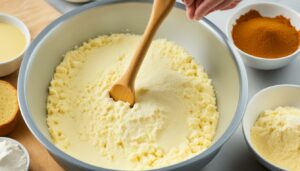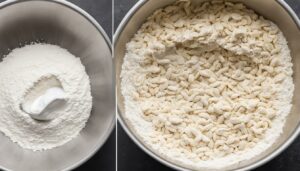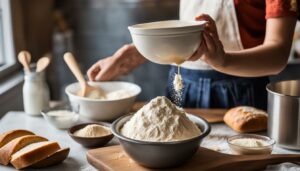Originally posted on April 6, 2024 @ 7:06 am
Did you know that sugar has long been a common ingredient in bread recipes, believed to enhance flavor and activate yeast? However, recent considerations have sparked a question: is sugar truly necessary in bread baking? In this article, we will explore the role of sugar in bread recipes and discover if there are healthier alternatives to achieve delicious homemade loaves without sugar.
Contents
- 1 The Role of Sugar in Bread
- 2 Omitting Sugar From Bread Recipes
- 3 Flavour Considerations
- 4 The Impact of Sugar on Bread Texture
- 5 Customizing Sugar Levels in Bread Recipes
- 6 Tips for Reducing Sugar in Yeast Bread
- 7 Other Considerations for Sugar Reduction in Bread
- 8 Conclusion
- 9 FAQ
- 9.1 Do bread recipes need sugar?
- 9.2 What is the function of sugar in bread?
- 9.3 Can bread be made without sugar?
- 9.4 Does sugar contribute to the flavor of bread?
- 9.5 What is the impact of sugar on bread texture?
- 9.6 How can I adjust sugar levels in bread recipes?
- 9.7 What are some tips for reducing sugar in yeast bread?
- 9.8 How do I reduce sugar in specific bread recipes?
- 9.9 Is sugar necessary in bread recipes?
- 10 Source Links
Key Takeaways:
- Sugar is not essential for yeast to function properly in bread baking.
- French bread and other traditional recipes can be made without sugar and still yield great results.
- There are various alternatives to sugar that can be used in bread making, such as honey or maple syrup.
- The majority of the flavor in bread comes from the alcohol produced during fermentation, not the sugar added.
- The impact of reducing or omitting sugar on bread texture can be minimal and can be adjusted based on personal preference.
The Role of Sugar in Bread
When it comes to bread making, sugar plays a crucial role in the process. It serves as a food source for yeast, which is responsible for the bread’s rise and texture. Yeast breaks down the starches and sugars present in the flour or other ingredients, producing carbon dioxide as a byproduct. This carbon dioxide is what causes the bread to rise and become light and fluffy.
By adding sugar directly to the dough mixture, you can speed up the activation of yeast and facilitate a quicker rise. The sugar acts as a catalyst, providing the yeast with an ample food supply to fuel its fermentation process. This, in turn, results in a faster rising dough and a shorter overall baking time.
However, it’s important to note that while sugar enhances yeast activation and accelerates the bread rising process, it is not an indispensable ingredient. Yeast can still function properly and break down the starches in flour to produce carbon dioxide without the addition of sugar. The role of sugar in bread making is more of a facilitator, expediting the fermentation process by providing an easily accessible energy source for the yeast.
The Importance of Sugar in Yeast Activation
“Sugar acts as a food source for yeast, facilitating its activation and enhancing the bread’s rise.”
Without sugar, yeast would still be able to perform its primary function of breaking down starches and producing carbon dioxide. However, the absence of sugar may result in a slightly longer rise time as the yeast relies solely on the starches available in the dough. The addition of sugar can help ensure a more efficient and timely rise, especially in recipes that require a quick turnaround.
It’s worth mentioning that the function of sugar in bread extends beyond yeast activation. Sugar also contributes to the overall flavor and crust color of the bread. During the baking process, sugar caramelizes, leading to a golden-brown crust and a slightly sweeter taste. The amount of sugar used in a recipe can therefore impact both the texture and flavor profile of the bread.
| Sugar Function in Bread | Impact |
|---|---|
| Yeast Activation | Promotes faster rising and fermentation |
| Flavor Enhancement | Contributes to the overall taste and crust color |
While sugar is an important ingredient in bread making, it is not essential. Depending on personal preference and dietary considerations, you can experiment with reducing or omitting sugar from your bread recipes. There are alternative sweeteners available, such as honey or maple syrup, that can be used as substitutes for sugar. Ultimately, the decision to include or exclude sugar in your bread recipes should be guided by your desired taste, dietary needs, and baking preferences.
Omitting Sugar From Bread Recipes
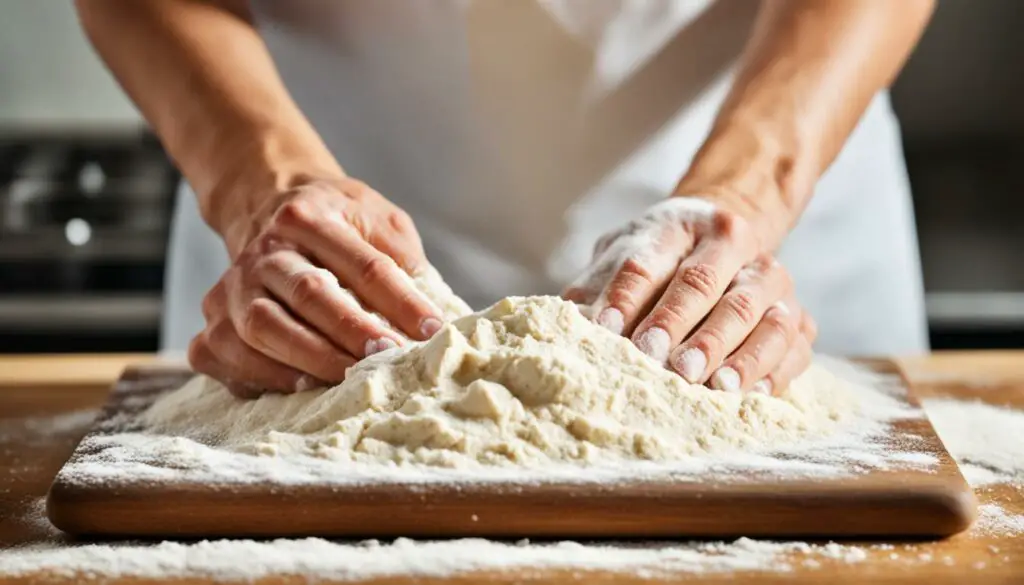
Many traditional bread recipes include sugar, but it is entirely possible to make delicious bread without sugar. Classic recipes like French bread are typically made without the addition of sugar, proving that bread can still be flavorful even without this ingredient. By omitting sugar from bread recipes, you can reduce unnecessary added sugars in your diet and enjoy a healthier alternative. The best part is that removing sugar does not significantly impact the texture or structure of the bread, so you can still achieve fantastic results.
If you’re wondering how to make bread without sugar, there are various alternatives you can explore. Instead of using sugar, you can substitute it with natural sweeteners like honey or maple syrup. These alternatives not only add a gentle sweetness to the bread but also contribute additional flavors that can enhance the overall taste. You can experiment with different ratios to find the perfect balance that suits your preferences. Just remember to adjust the sweetness perception accordingly.
When it comes to sugar-free bread recipes, it’s important to note that the absence of sugar may affect the browning and rising process to some extent. However, these effects can be managed by adjusting the baking times and temperatures. It may require a bit of trial and error, but the end result will be a homemade bread that is not only free of added sugars but also tailored to your liking.
“Omitting sugar from bread recipes is a great way to reduce unnecessary added sugars in your diet, without compromising on flavor or texture.”
So, if you’re looking to make bread without sugar, don’t be afraid to try new recipes and explore alternative sweeteners. Embrace the creativity and adaptability of bread making and enjoy healthier homemade loaves that are just as delicious as their sugary counterparts.
Here’s a simple sugar-free bread recipe to get you started:
- Combine 2 cups of all-purpose flour, 1 teaspoon of salt, and 1 packet of active dry yeast in a mixing bowl.
- Add 1 cup of warm water and 2 tablespoons of olive oil to the dry ingredients. Mix well until a dough forms.
- Knead the dough on a floured surface for about 5-7 minutes until it becomes smooth and elastic.
- Place the dough in a greased bowl, cover it with a clean kitchen towel, and let it rise in a warm place for about 1 hour or until doubled in size.
- Punch down the dough to release any air bubbles and shape it into a loaf. Place it in a greased loaf pan.
- Cover the loaf pan with the kitchen towel again and let the dough rise for another 30 minutes.
- Preheat the oven to 375°F (190°C) and bake the bread for 25-30 minutes or until it sounds hollow when tapped on the bottom.
- Remove the bread from the oven and let it cool before slicing and enjoying your homemade sugar-free bread!
Feel free to experiment and add your own twist to this recipe. Remember, making bread without sugar is all about customization and finding what works best for you.
Flavour Considerations
When it comes to the flavour of bread, some argue that sugar plays a significant role. However, the reality is that the added sugar in bread recipes primarily serves as a food source for the yeast during the fermentation process. As the yeast breaks down the starches and sugars, it produces carbon dioxide and alcohol, which are the key factors in bread’s flavour profile.
During the fermentation process, the sugar added to feed the yeast gets broken down, leaving very little sugary flavor in the final product. Instead, the majority of the flavour in bread comes from the alcohol produced during fermentation. This alcohol contributes to the unique taste and aroma of bread, especially when the dough is allowed to ferment for longer periods or undergo multiple fermenting cycles.
While sugar can enhance the fermentation process and contribute to the overall flavour of bread, its impact is minimal compared to the alcohol produced during fermentation. Therefore, the choice to include or omit sugar in bread recipes ultimately depends on personal preference.
It is important to note that the flavour profile of bread can be customized by adjusting various factors such as fermentation time, temperature, and the type of yeast used. These adjustments can result in different levels of alcohol production, which, in turn, can influence the bread’s taste. So for those who prefer a stronger, sourer flavour, allowing the dough to ferment for a longer time or multiple times can achieve this desired outcome.
Overall, the inclusion of sugar in bread recipes is not the primary factor influencing its flavour. While sugar can contribute to the fermentation process and enhance the overall taste, the majority of the flavour comes from alcohol production during fermentation. As a result, bakers can customize the flavour of their bread by adjusting the fermentation process and exploring other variables that impact flavour development.
Key Takeaways:
- The added sugar in bread primarily serves as a food source for the yeast during fermentation.
- The sugar gets broken down during fermentation, resulting in very little sugary flavour in the final product.
- The majority of the flavour in bread comes from the alcohol produced during fermentation.
- Customizing flavours in bread can be achieved by adjusting fermentation time, temperature, and yeast selection.
- The choice to include or omit sugar in bread recipes depends on personal preference.
The Impact of Sugar on Bread Texture
Sugar plays a significant role in the texture of bread due to its hygroscopic nature, which means it attracts and retains moisture. When sugar is reduced in yeast bread recipes, it can affect the moisture retention and ultimately impact the texture of the bread.
Reduced-sugar breads may have a slightly drier texture compared to breads with higher amounts of sugar. However, the decrease in moisture level is usually subtle and may not be noticeable in small reductions of sugar. It’s important to note that the impact of sugar on bread texture can be adjusted based on personal preference and the desired outcome.
For sweet yeast breads, a higher amount of sugar can help retain moisture and result in a slightly softer texture. The sugar acts as a humectant, preventing the bread from drying out quickly. However, it’s worth noting that excessive amounts of sugar can lead to a cake-like texture, which may not be desirable for certain bread recipes.
Overall, while sugar does contribute to the texture of bread, its impact is minimal and can be modified by adjusting the amount or using alternative ingredients. In the next section, we will explore how to customize sugar levels in bread recipes to achieve the desired texture and taste.
Table 5: Comparing the Texture of Bread with Different Sugar Levels
| Sugar Level | Texture |
|---|---|
| High amount of sugar | Slightly softer texture |
| Reduced amount of sugar | Slightly drier texture |
| No sugar | Texture similar to breads made with reduced sugar |
Customizing Sugar Levels in Bread Recipes
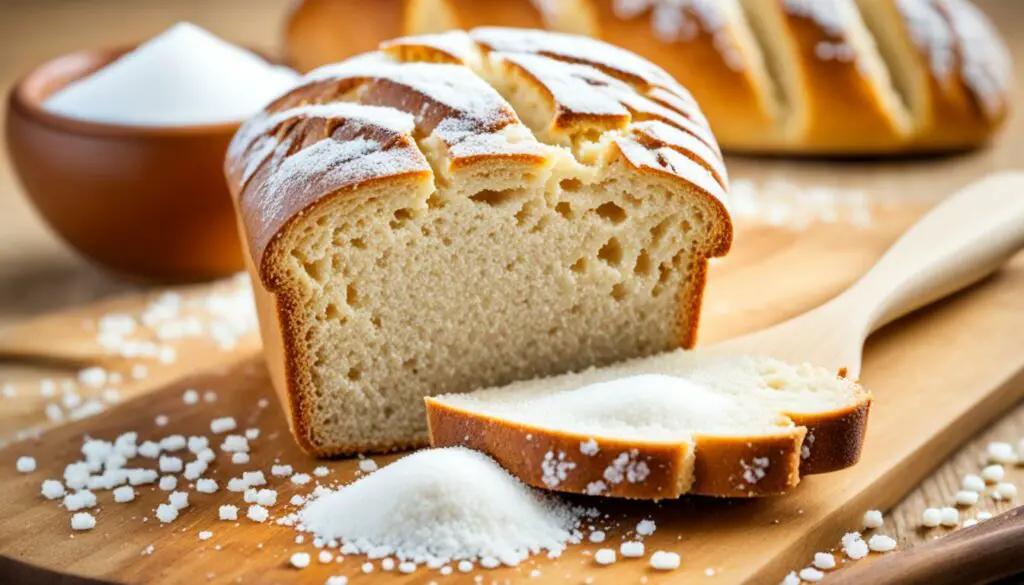
When it comes to adjusting sugar levels in bread recipes, one useful concept to consider is the baker’s percentage. The baker’s percentage is a ratio that compares the weight of an ingredient to the weight of the flour in a recipe. Understanding the baker’s percentage can help gauge the sweetness of bread and determine how much sugar can be reduced while still achieving the desired level of sweetness.
The baker’s percentage allows bakers to customize sugar levels according to personal preference and sweetness perception. By experimenting with different percentages, you can find the right balance that suits your taste. It’s important to remember that sweetness is subjective, and individuals may have varying perceptions of sugar levels in bread.
Here’s an example to illustrate how the baker’s percentage works:
Let’s say a bread recipe calls for 500 grams of flour and 10 grams of sugar. The baker’s percentage for sugar in this recipe would be calculated as follows:
Sugar percentage = (10 grams / 500 grams) x 100%
Sugar percentage ≈ 2%
In this example, the sugar represents approximately 2% of the total flour weight. Based on your desired sweetness level, you can adjust the sugar percentage up or down accordingly.
It’s worth noting that the baker’s percentage can be used not only for sugar but also for other ingredients in bread recipes. By understanding this ratio, you can have more control over the overall composition and flavors of your bread.
Experimenting with Sweetness Perception
Sweetness perception can vary from person to person, so it’s important to experiment and find the right balance for your taste. You may find that reducing the amount of sugar slightly still provides the desired level of sweetness, while allowing other flavors in the bread to shine. Alternatively, you can explore using alternative sweeteners such as honey or maple syrup to achieve sweetness with a different flavor profile.
Remember, the goal is not to eliminate sugar altogether, but rather to find a healthier and more personalized option. Customizing sugar levels in bread recipes can help you enjoy delicious homemade bread while managing your sugar intake.
In the next section, we will provide practical tips for reducing sugar in yeast bread without compromising flavor or texture.
Tips for Reducing Sugar in Yeast Bread
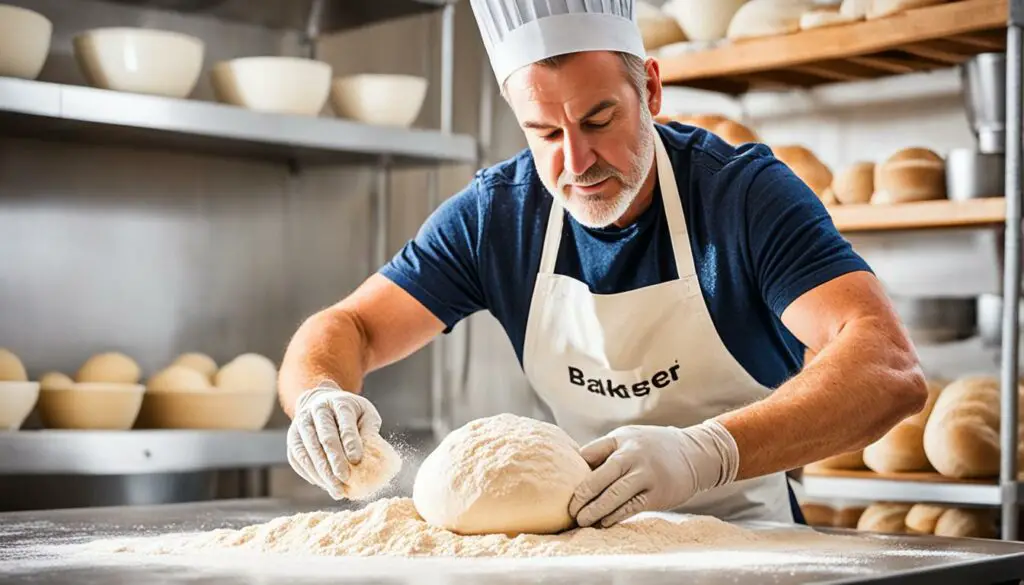
Reducing sugar in yeast bread doesn’t mean compromising on flavor or texture. There are several tips and considerations that can help you achieve delicious homemade bread with reduced sugar content. Here are some suggestions to guide you:
- Start with sugar-free recipes: Look for bread recipes that don’t include any sugar in the ingredient list. This eliminates the need for reducing sugar altogether.
- Let yeast do its thing: Yeast has the ability to create its own food supply by breaking down the starches present in flour. This means that even without added sugar, yeast can still produce carbon dioxide and help bread rise.
- Choose specialized yeast: For breads that require higher sugar levels, consider using special yeast strains like SAF Gold. These yeast varieties are formulated to handle high-sugar environments and can help achieve faster rising.
- Consider sugar as a condiment: Rather than making sugar the main attraction of your bread, treat it as a condiment. Use a minimal amount of sugar to add a touch of sweetness without overpowering other flavors.
It’s important to note that reducing sugar in yeast bread may have some impact on both browning and rising. However, these effects can be managed through simple adjustments in baking times and temperatures. By following these tips, you can create bread with reduced sugar content while still enjoying a flavorful and satisfying end result.
Expert Tip: Choosing the Right Sweetener
When reducing sugar in bread recipes, consider using alternative sweeteners like honey or maple syrup. These natural sweeteners can add depth of flavor and subtle sweetness to your bread while reducing the overall sugar content. Experiment with different sweeteners to find the one that best suits your taste preferences.
Other Considerations for Sugar Reduction in Bread

When it comes to reducing sugar in yeast bread recipes, there are additional factors to consider beyond the basic recipe adjustments. These considerations include the specific type of bread, alternative sweet ingredients, and the impact of baking at altitude or in gluten-free recipes.
The Type of Bread
Each type of bread has different flavor profiles and intended sweetness levels. When reducing sugar in bread recipes, it’s important to consider the overall flavor balance desired. Some breads, like sweet rolls or cinnamon bread, rely on added sweet ingredients such as dried fruit or chocolate to achieve their delicious taste. In these cases, reducing the sugar in the dough can help strike the right balance of flavors without sacrificing sweetness. The objective is to create a well-rounded taste that complements the specific bread variety.
Alternative Sweet Ingredients
Reducing sugar in bread recipes doesn’t mean sacrificing sweetness altogether. There are various alternative sweet ingredients that can be used to replace or decrease the amount of sugar. Natural sweeteners like honey, maple syrup, or agave nectar can impart a subtle sweetness to the bread while providing a unique flavor profile. Experimenting with different sweeteners allows bakers to discover their preferred alternatives and tailor the bread’s taste to their liking.
Baking at Altitude and Gluten-Free Baking
Factors like baking at high altitudes or preparing gluten-free bread can affect the outcome when reducing sugar. At high altitudes, adjustments to baking time and temperature may be necessary to ensure the bread bakes evenly. Gluten-free baking often requires alternative flours and binding agents, and these changes can also influence the overall sweetness and texture of the bread. Bakers should adapt their sugar reduction strategies to accommodate these specific circumstances and consider taste-testing to achieve the desired results.
By taking into account the type of bread, exploring alternative sweeteners, and adjusting for unique baking conditions, bakers can confidently reduce the amount of sugar in their bread recipes without compromising flavor or texture. Experimentation and taste-testing play a significant role in finding the perfect balance that suits individual preferences and dietary needs.
Conclusion
In conclusion, the necessity of sugar in bread recipes is not as crucial as it may seem. While sugar has been a traditional ingredient in bread baking, it is not essential for successful outcomes. Yeast can effectively ferment the starches in flour without the addition of sugar, allowing bread to rise and develop its characteristic texture and flavor.
For those looking to reduce or eliminate sugar from their homemade bread, there are alternative options available. Experimenting with different recipes and adjusting sugar levels can help achieve delicious and healthier bread without compromising taste or texture.
The decision to include or omit sugar ultimately comes down to personal preference and dietary considerations. Whether you choose to use sugar or explore alternatives, the joy of baking homemade bread remains unchanged. So go ahead and get creative in your kitchen, and enjoy the satisfaction of a warm, freshly-baked loaf, tailored to your own preferences.
FAQ
Do bread recipes need sugar?
No, sugar is not essential for successful bread baking. Yeast can ferment the starches in flour without the addition of sugar.
What is the function of sugar in bread?
Sugar acts as a food source for yeast, speeding up yeast activation and helping the dough rise more quickly.
Can bread be made without sugar?
Yes, many bread recipes can be made without sugar, such as French bread, which is traditionally made without sugar. There are also alternatives to sugar that can be used in bread making.
Does sugar contribute to the flavor of bread?
The sugar added to feed the yeast gets broken down during fermentation, resulting in little sugary flavor remaining in the final bread. The majority of the flavor comes from the alcohol produced during fermentation.
What is the impact of sugar on bread texture?
When sugar is reduced in yeast bread, the resulting bread may have a slightly drier texture. However, the decrease in moisture level is usually subtle and may not be noticeable in small reductions of sugar.
How can I adjust sugar levels in bread recipes?
The baker’s percentage can be used to determine how much sugar can be reduced while still achieving a desired level of sweetness. Experimentation with different percentages can help find the right balance.
What are some tips for reducing sugar in yeast bread?
Start with recipes that do not use any sugar, use special yeast for high-sugar breads, and consider sugar as a condiment rather than the main attraction of the bread. Adjusting baking times and temperatures can also help manage the effects of reduced sugar on browning and rising.
How do I reduce sugar in specific bread recipes?
For breads that rely on added sweet ingredients, reducing sugar in the dough can help achieve a better flavor balance. Adjust fillings and frostings to maintain the desired level of sweetness. Considerations such as baking at high altitudes or gluten-free baking may also influence sugar reduction strategies.
Is sugar necessary in bread recipes?
No, sugar is not necessary in bread recipes. It is possible to achieve delicious and healthier homemade bread without the addition of sugar.


